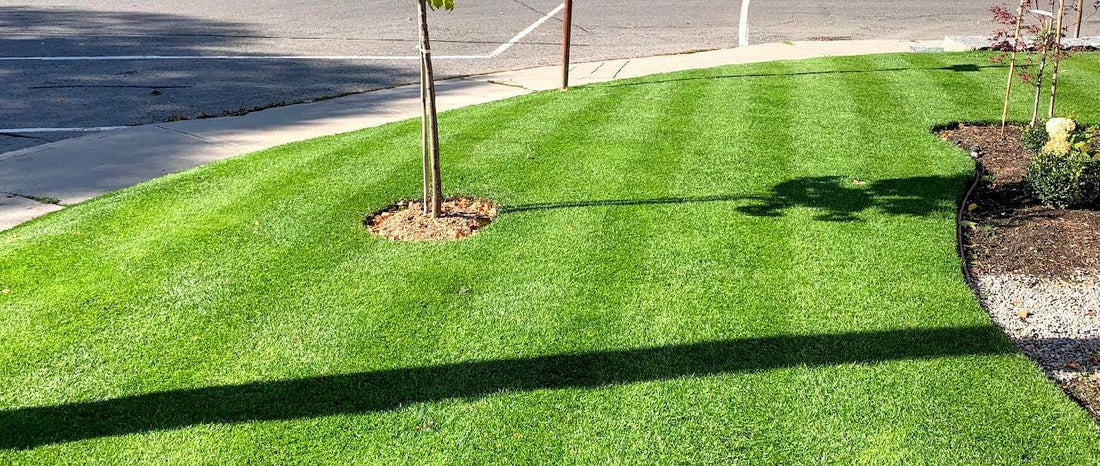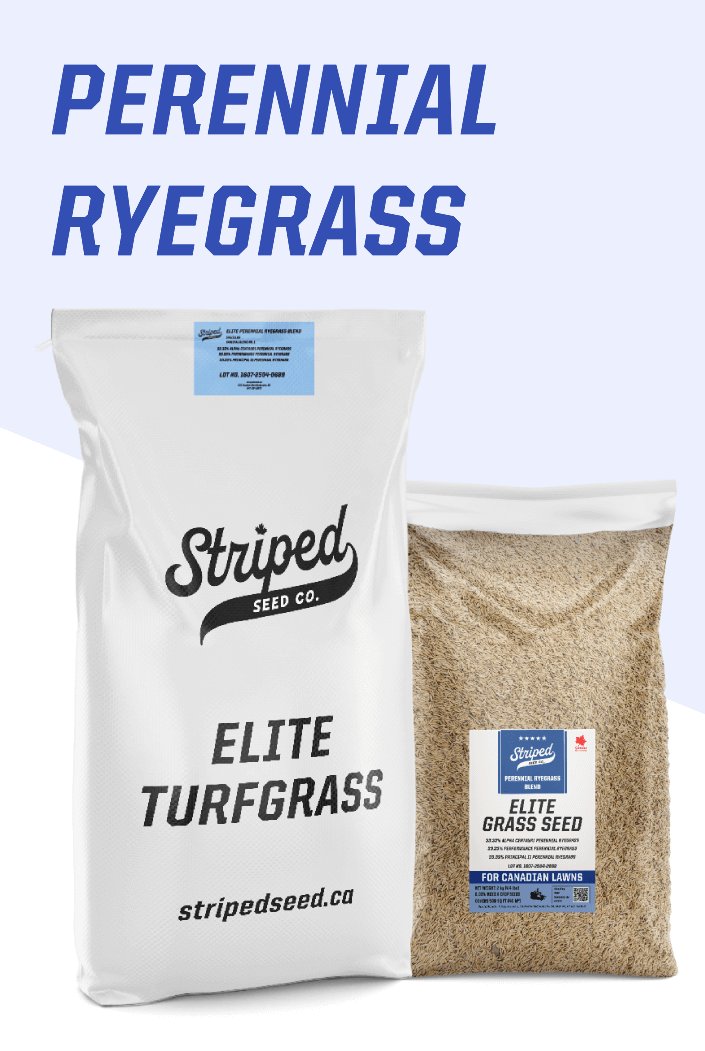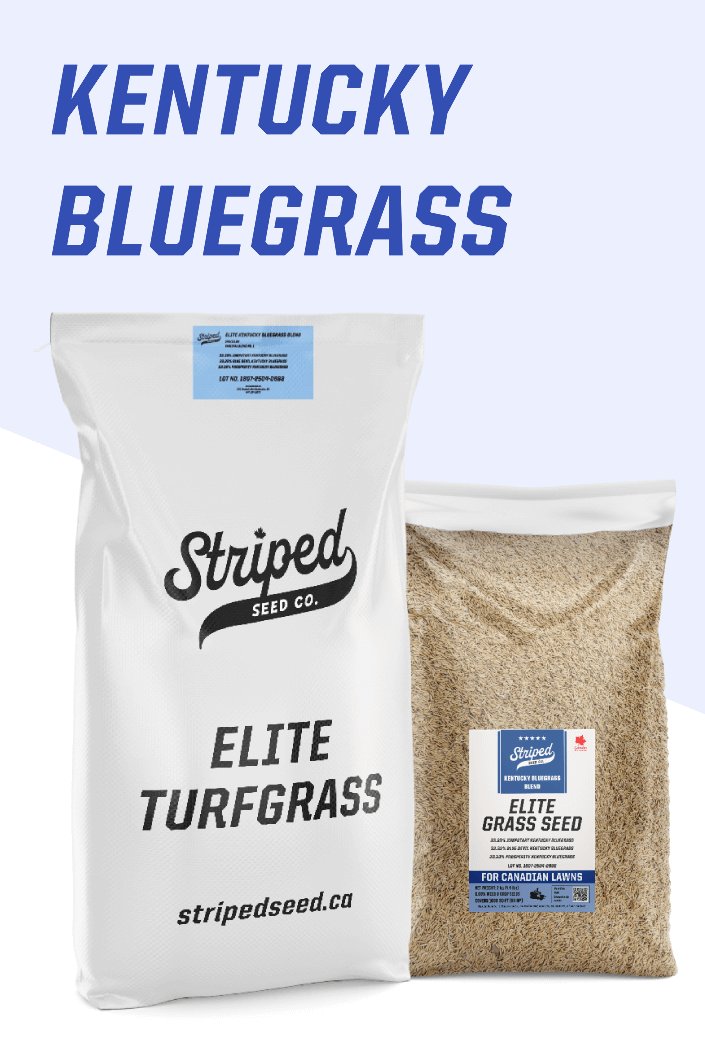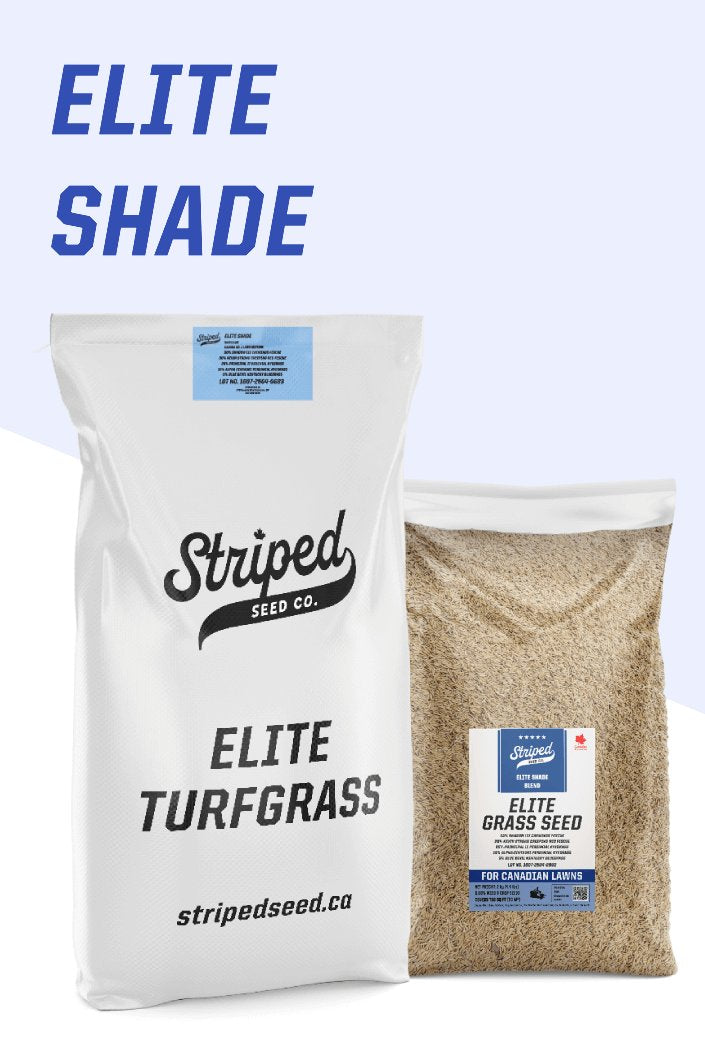Overseeding your lawn is one of the biggest lawncare “cheat codes” if you want to fix a thin, patchy lawn or go from a nice lawn to one of the best in your neighbourhood. Overseeding enhances your existing lawn with new, healthy grass making your lawn thicker, more dense, and more attractive—sometimes in as little as two weeks.
That’s why overseeding is one of the first steps you should consider if you’re looking to improve your lawn—plus, it improves curb appeal and makes your mowing experience more enjoyable. Below is a battle-tested 10-step process for completing a successful overseed project that results in robust germination and sets you on the path to lawn domination.
Table of contents
What is Overseeding?
Overseeding is the process of planting grass seed directly into an existing lawn. It’s as simple as that. Most of the time when people are planting grass seed, they are overseeding. If you're planting grass seed into a yard with no existing lawn that is completely bare soil—perhaps after a new home build—this would not be considered overseeding.
Why Overseed Your Lawn? The Benefits
Overseeding enhances your lawn by increasing grass density and filling-in bare patches. You get more, new healthy grass so your lawn looks thicker and more lush. In turn, this helps control weeds because they have a harder time germinating and taking hold in a more dense lawn.
But overseeding also provides you with an opportunity to improve your lawn not just with new grass, but also with modern, higher-quality professional-grade grass that is now available homeowners. Unlike common seed found in big-box stores, certified, elite grass seed blends and cultivars have superior genetics, deliver more robust germination, have higher purity (i.e. lower weed content), better resistance to common pests and diseases, and darker color. Which all results in a more resilient and attractive lawn.
Lastly, overseeding gives you a more affordable way to take the lawn you already have and improve it without getting into a major lawn renovation or removing turf and bringing in sod, which can be very expensive.
How Often Should You Overseed Your Lawn?
Many people never overseed their lawn and live with the same tired-looking grass for decades. I’m not judging them (well, maybe a little bit), but the fact that you’re reading this means you’re already well ahead of most homeowners and likely en-route to having a better-than-average lawn.
On the other end of the spectrum are professional sports fields that are overseeded by their turf staff as frequently as every week during the growing season. A joint study led by Cornell University that looked at optimal overseeding frequency found that weekly overseeding of athletic fields under high traffic conditions provided excellent season-long turf density. That’s a lot of grass seed and a lot of time, and unnecessary for the average homeowner—unless you’re hosting weekly football games your backyard.
There’s no hard and fast rule for how frequently you should overseed your home lawn and it really depends on the current condition of your lawn. Consider when it was last seeded. Are you dealing with any thin areas or past issues from pests, disease, or foot traffic? These are the things to consider when deciding whether your lawn could use an overseed.
It's not uncommon for lawn enthusiasts to overseed their lawn every year as a standard practice— sometimes multiple times—as part of their effort to keep a “best in show” lawn and because it’s an enjoyable and rewarding project for those who see lawncare as a hobby.
When is The Best Time of Year to Overseed Your Lawn?
For those of us in Canada and the Northern U.S. with lawns containing cool season grass varieties (bluegrass, ryegrass, fescue), the best time of year to overseed your lawn is:
- Mid spring
- Late-summer / early-fall
That means you’ve got two good windows of opportunity each year to make improvements to your lawn with an overseeding project.
In the springtime, wait until soil temperatures are between 10°C-18°C (50°-65°F) and the daytime air temperature is averaging 15°C (60°F). At these temperatures the soil is warm enough to induce germination and the threat of overnight frost has usually passed. You can measure soil temperature with a meat thermometer from your kitchen. For most of the northern United States, Western Canada, Central Canada, and Eastern Canada this is typically late-April-May.
While springtime is the first seeding opportunity, late-summer to early-fall is the best time of year to plant grass seed. The threat of a heat wave—something that can put significant stress on immature grass—has usually passed but the soil remains warm. The warm days and cool nights create ideal growing conditions and fall offers the longest runway of time to establish and harden new grass before unfavourable temperatures arrive—in this case cold weather from the onset of winter.
In the spring, it’s the arrival of a summer heat wave that you need to consider in your planning when performing a spring overseed. The window of time in the spring from when the ground is warm enough to facilitate germination to the onset of severe summer heat is shorter than the growing window you get in the fall.
Why You Should Trust this Article
Like many things in lawncare, there isn't one "right" way to perform an overseed project. You can achieve good results with a slightly different ordering of steps or choice of materials than what is outlined in the 10-step plan below.
But the process below is the one we have arrived at and refined after taking our own trial and error learnings from dozens of overseeding projects and our customer's lawn transformation projects, and cross referencing that experience with academic research and studies from university turfgrass programs.
Below are some examples of lawns that we've overseeded and the end of this article you'll find more 'overseeding before and after photos' from some of our customers.

How to Overseed A Lawn: 10 Steps
⚡️Pro tip: Before you begin your overseed project, consider re-reading this post to decide which materials and products you want to use, and any tools or equipment you may need to add to your arsenal. Then make a list that you can use to source everything you need before you begin. This will help avoid having to interrupt your project while you’re in the middle of it to run to the store for something you missed or something you didn’t buy enough of.
Step 1: Mow Low and Collect Clippings

I start by mowing the grass short and bagging the clippings. The goal here is twofold:
-
It lets the seed get down to the soil where it needs to be.
-
It helps your new seedlings compete with the existing grass for sunlight.
While you're waiting for the new seed to sprout, your lawn will still be growing, and you'll need to wait a couple of weeks before mowing it for the first time. Some people like to scalp their lawns before seeding, but if you normally keep yours at 2"-4", I recommend taking it down to around 1.5". This helps the new seeds get to the soil without stressing out the existing grass too much. But if you're starting with an ugly and thin lawn you don't care about saving, then scalp away!
Collecting the clippings as you go will leave you with a cleaner slate to start with. Clippings do add nutrients to the lawn. But when seeding, I prefer to remove them. This way, they won't block the seeds from reaching the soil. If you don't have a mower that bags clippings, use a rake or leaf blower to collect them.
Cutting your grass short helps your seed get down to the soil. It also makes the other steps we are about to cover easier.
Step 2: Dethatch and Prepare Seed Bed
In order for grass seed to germinate, it needs adequate seed-to-soil contact. While dethatching your lawn isn’t always necessary before overseeeding, it's an effective way to remove dead material and some of the thatch layer that can build up in lawns. This can help make sure your grass seed is finding its way down to the soil.
A manual dethatching rake works well for smaller lawns. Another style of rake is The Groundskeeper II rake. It's lightweight with steel tines and is popular in the lawncare community because of how effectively it pulls up thatch.
For larger lawns, or to save on some effort, consider a walk-behind dethatcher. Greenworks and SunJoe both make corded models that do a good job removing thatch material and roughing-up the soil to make it more accepting of grass seed.
In general, your goal with this step is to remove any dead grass or thatch material and loosen up the soil in your lawn (particularly in any bare patches).
Once you’ve done this, you'll have a mess of brown grass all over your lawn. An easy way to clean up is to go over your lawn again with your rotary mower with the bagger on to “vacuum up” any dead material and debris.
Aeration (Optional)
This is also the step where you want to consider aerating your lawn. Aerating is when you pull cores or plugs out of your lawn in order to relieve soil compaction and help nutrients and airflow get into the ground. A simple way to test whether your soil is compacted is by seeing how easily (or not) a screwdriver can be plunged into the ground. If you’re met with a lot of resistance, you may want to consider aeration. Again, keep in mind this will require more time and effort and can also be quite taxing on the body if you do it yourself.
Step 3: Amend Soil and Topdress Lawn (Optional)
In addition to loosening-up the seed bed, this step is also a good opportunity to topdress your lawn with topsoil, compost, or sand, and add any soil amendments to improve your soil and also level it a bit by filling in low spots. It’s much easier to push material around when your lawn is scalped than when your grass is tall. You want to aim for about 1/4" of material. You can use a landscape rake or a lawn levelling tool to distribute your topdressing evenly.
But keep in mind this will add cost and time to your project and can be treated as an optional step if you're trying to save on time and budget.
Step 4: Dial-In Your Irrigation Setup
It’s at this stage, before your grass seed has been put down and covered, that I recommend you determine what your irrigation setup is going to look like if you’ll be using a hose and manual sprinkler. That means doing some trial and error to figure out where you need to position your sprinkler and how much flow you need to allow in order to get the best coverage possible.
After determining where you want to locate your sprinkler(s) for the duration of your seeding project, you can mark the position in your lawn with a marking flag (or anything really). Doing this now will help minimize walking back and forth across your freshly seeded lawn later and making a mess of things as the area becomes wet from your sprinkler while you adjust it a dozen or so times.
If you already have in-ground irrigation then you don’t need to worry about this step presuming things are working properly and coverage is adequate.
Step 5: Choosing Your Grass Seed for Overseeding
⚡️Pro Tip: Need help figuring out which grass seed to use for your specific lawn scenario? Take our free, 2-minute quiz to get a customized recommendation.
There are a few things to consider when choosing grass seed for your overseed project. Some varieties—like perennial ryegrass and fescues—are better for overseeding because they germinate and establish quickly and can therefore compete with the existing turf. Which means you can get on your newly overseeded lawn and mow it for the first time before the existing grass has become a total jungle.
Perennial ryegrass in particular is widely regarded as an excellent variety for overseeding. In the same Cornell overseeding study mentioned above, high-traffic athletic field areas overseeded weekly with perennial ryegrass were able to maintain almost 90% density and tall fescue areas had between 70% and 80% density at the end of the study. In contrast, the study found that overseeding with Kentucky bluegrass (KBG) proved relatively ineffective on high-traffic athletic fields, most likely due to the long germination and establishment requirement.
This doesn't mean you can’t overseed Kentucky bluegrass on your home lawn, however it is more challenging. Even though you don’t have the same foot traffic as an athletic field, you’ll still need to stay off your lawn for upwards of 3-4 weeks after seeding before you can get on it to mow in order to give your baby Kentucky bluegrass a chance to germinate and establish.
Beyond grass variety, the other factor to consider is your specific environmental conditions particularly when it comes to sun vs shade. For example, you may want to look for a shade specific grass seed blend or cultivar if you’re dealing with low-light conditions.
Lastly, there’s grass seed quality. All grass seed is not created equal and overseeding is a great opportunity to improve your lawn by introducing higher quality, elite grass seed cultivars if it’s in your budget.
Elite grass seed has superior genetics, higher purity, and offers enhanced turf quality. It's specifically bred by growers to optimize performance across attributes like (dark) colour and disease, drought, and foot traffic tolerance. One thing to keep in mind is that even though elite grass seed is more expensive up front than common, non-certified seed found in big-box stores, its better performance means in the long run, it can actually save you money by requiring less frequent interventions and improvements over time.
Step 6: Spread the Grass Seed
Now that you have the stage set and your seed selected, it’s time to plant your grass seed. If possible, try to do this the same day or the day after you scalped your lawn to give your seedlings the best chance to compete with the existing turf.
Before you begin, determine the amount of seed needed by checking the recommended seeding rate specified on your seed bag or the product information that was supplied with your purchase—taking into account your lawn's size which you can measure using Google maps.
For smaller lawns, I recommend using a manual hand-crank spreader. I’ve tried battery-powered handheld spreaders and while they work well initially, I've found they often stop working after a year or two, especially if you use them to spread heavier products like fertilizer. After going through two battery-powered units, I've switched to manual-crank hand spreaders, which in my experience prove more reliable and let you skip fussing with dead batteries.
For larger lawns you can use a walk-behind broadcast spreader or a drop spreader. Cheap broadcast spreaders are widely available at big box stores and are most commonly used. Drop spreaders are more expensive but come with the advantage of more precision and less seed flying into unwanted areas like garden beds and sidewalks, as the seed falls directly downwards rather than being flung outwards in a cyclone motion like with broadcast spreaders.
When it comes to spreader settings on cheap big box store units, I recommend against relying too heavily on the manufacturer's recommendations and instead treat them as a ballpark guideline. Due to manufacturing variations and cheap parts, the recommended setting might have you starting with the hopper too far open causing you to run out of seed before you complete all your passes. Instead, start with your spreader nearly closed and gradually open it one click at a time until the seed is flowing out evenly in a moderate yet conservative fashion. It's better to make multiple and repetitive passes across your lawn rather than run out of seed before covering the entire area.
For effective coverage, begin by making a pass around the perimeter of your lawn first. Most spreaders include a side guard that you can engage to prevent seed from reaching garden beds or sidewalks. After completing the perimeter, go over your lawn twice if you can—once lengthwise and once widthwise, maintaining a steady walking pace to ensure even distribution of seed.
Step 7: Rake and Roll-in Seed
After spreading your grass seed, one of the most crucial steps is making sure your grass seed has excellent seed-to-soil contact and that it is lightly covered. In instances where people don’t get the germination results they were hoping for with their overseed project, failing to perform this step (and step 8 below) adequately is often one the culprits.
Start by taking a regular garden rake and lightly dragging it across your lawn to knock down any seed sitting in the canopy of the existing grass and integrate it into the soil. This should also help cover some of the seed with the existing soil or topdressing (if you applied it). A lawn levelling tool also works really well for this step if you have one.
For really large lawns, you can tow a drag mat or section of chain link fence with a piece of carpet attached to it to tackle this step.
After lightly raking-in your seed, the next step is ensuring good seed-to-soil contact by pressing your seed into the ground somehow. Most often this is done with a lawn roller. Sometimes people have a natural instinct to want to stay off the lawn as soon as the seed has hit the ground. But this is actually the time when you want to get on your lawn and compress your entire seeding project to establish solid contact with the soil. The folks at Purdue University Turf Science confirm that “light rolling is effective immediately following seeding to ensure good seed-soil contact.”
This compression creates a more resilient seeding project that better withstands rain, wind, and animal activity. If you have a lawn roller, you don’t need to fill it up completely with water—just enough so that it has enough weight to be able to compress the soil. The rolling process helps to "lock everything together”—creating optimal conditions for germination.
If you don't have access to a lawn roller, look for other items in your garage or shed that might work. For instance items with wheels that you could roll over the area, adding weight if necessary. If you happen to have a powered-reel mower with a striping drum, or a striping kit attachment for your rotary mower, those can work as well. And if your lawn is small enough, you can simply walk over the seeded area, tamping things down by foot.
Step 8: Cover Your Seed
Next you want to choose something—like peat moss—to cover your entire seeding project. This is key! It helps maintain moisture, contributes to seed-to-soil contact, and helps to protect seeds from sunlight that will dry them out, as well as hungry birds or other wildlife.
For most residential lawns, peat moss is an excellent choice as a covering material. It excels at moisture retention and provides a helpful visual indicator of hydration levels—when the color starts to change from dark to light brown, you know it's time to water. This visual cue makes figuring out your watering schedule easier. Aim to apply approximately 1/4 inch of peat moss over your grass seed—enough to provide protection without burying the seed too deeply. As a general guideline, I find one large cube of peat moss from a garden centre typically provides good coverage for 500-750 square feet of lawn area. If your budget allows, err on the side of more generous coverage.
You can also use topsoil to cover your seed; it just doesn’t have the same moisture retention and protective spongy properties that peat moss does. Regardless of which material you choose, the key is maintaining roughly a quarter-inch of coverage depth—enough to protect and fully cover the seed while still allowing it to emerge easily once germination begins.
For sloped areas, consider using burlap as your covering material. It's good at keeping things in place and preventing erosion, especially if rain is in the forecast. The burlap helps hold everything together, preventing your carefully spread seed from washing down the slope and creating uneven germination.
For larger lawns where peat moss might be cost-prohibitive, seeding blankets or straw are options worth looking into.
Step 9: Watering
Establishing the right watering schedule is the other mission-critical step to ensure germination occurs. The goal is to keep the seed damp at all times until germination.
⚠️ Letting the seed dry out even once can sabotage germination and all your hard work.
That’s why if you don’t have an in-ground irrigation system that you can program to come on automatically and instead will be watering with a hose and manual sprinkler, I highly recommend you get yourself a hose timer so that you can water when you’re not home.
During your initial watering, run the sprinklers until the area is adequately saturated, but stop before water begins to pool or create little streams. This could be anywhere from 3-10 minutes depending on your sprinkler setup or irrigation system. Note the length of time it took. This will be roughly how long you run your sprinklers each time they come on, however, you may need to reduce this time by a minute or two as you will be watering an already damp lawn moving forward.
If possible, consider starting your overseed project on a weekend or a day when you’ll have time to monitor how quickly the area starts to dry out after being watered. This observation period will allow you to determine the times throughout the day when you should water. Watering frequency can vary based on sun exposure, location, and climate conditions.
If you can't actively monitor your watering, a general guideline is to water 3-4 times daily for 4-7 minutes per session—usually starting around 10a.m.
For manual sprinklers, position them in the locations you previously identified for optimal coverage. For those with in-ground irrigation systems, apply the same principles by setting up a new watering schedule based on observed drying patterns.
Maintain your watering schedule until you see germination, and continue it until the grass has begun to fill in any patchy areas—usually another 5-7 days post-germination. After that you can water once or twice per day for another week and then resume your normal watering program.
Remember that consistent moisture is absolutely crucial during the germination period - it's better to water more frequently for shorter durations than to let the soil dry out between longer watering sessions.
Step 10: Apply Starter Fertilizer
We used to recommend holding off on starter fertilizer until 5–7 days after germination (or when you can safely walk on the lawn). The idea was to avoid fueling a surge of top growth in your existing turf while new seed was still sitting on the surface—an approach you’ll hear from seasoned lawn enthusiasts more than in generic guides.
That advice is still solid if you’re using a standard big-box starter fertilizer that relies heavily on fast-release nitrogen (e.g., urea or ammoniacal N). Those formulas can fuel established turf quickly, which isn’t ideal when seedlings are just getting started and competing for light, moisture, and nutrients.
However, SeedLaunch Pro™ (our starter fertilizer) was engineered specifically for seeding projects to address this issue and is designed to be applied at the time of seeding. It features:
- Balanced 8-15-10 ratio to focus on establishment over excessive top growth.
- Polymer-coated, slow-release nitrogen (part of the total 8% N) that matches the pace of seedling growth and feeds steadily without surges.
- Soil-supporting components like biochar (CarbonCHARge™) and organic matter to create a seed-friendly top layer.
If you’re not using SeedLaunch Pro™ or a professional fertilizer from the golf course industry, the “wait-until-germination” method remains a great way to keep things balanced with typical retail fertilizers. In all cases, follow the label rate and keep the seedbed consistently moist—your preparation and watering do most of the work; fertilizer helps you get the most out of it.
When to Mow After Overseeding
Your newly overseeded lawn is typically ready to be mowed 1-2 weeks after germination or when the new grass reaches 1.5-2" in height. Standard lawncare advice usually says to wait two weeks and/or until the new grass is 2-4 inches high. Personally I prefer to mow as soon as possible as I maintain low-cut turf and I find it helps to stimulate growth and thickening.
If you have a manual push-style reel mower, consider using it for your first mow after overseeding. These lighter machines offer several advantages: they're easier to maneuver, put less stress on the delicate new grass, and can be lifted and turned around at the end of each pass rather than making potentially damaging turns on the lawn
After this first cut, resume your regular mowing schedule and enjoy the fruits of your labor.
Overseeding Case Studies and Examples
Below are some examples and before and after pictures from Striped Seed Co. customers who have used our elite grass seed blends to overseed their lawns.




FAQ
Can I just throw grass seed down without doing anything else when overseeding?
You can, but don’t expect much germination. Grass seed that is left to sit on top of soil uncovered and exposed to the elements typically does not germinate.
What about weed control when overseeding?
Overseeding your lawn in and of itself is a preventative step that helps with weed control as weeds have a harder time taking hold in a dense lawn. If you’re in the US where you have access and the ability to use a broad range of weed control products (not available to Canadians), then you can use mesotrione which is a post emergent that targets weeds but not grass. You’ll want to spray it at the recommended rate after you have covered your seed and before you start watering.




